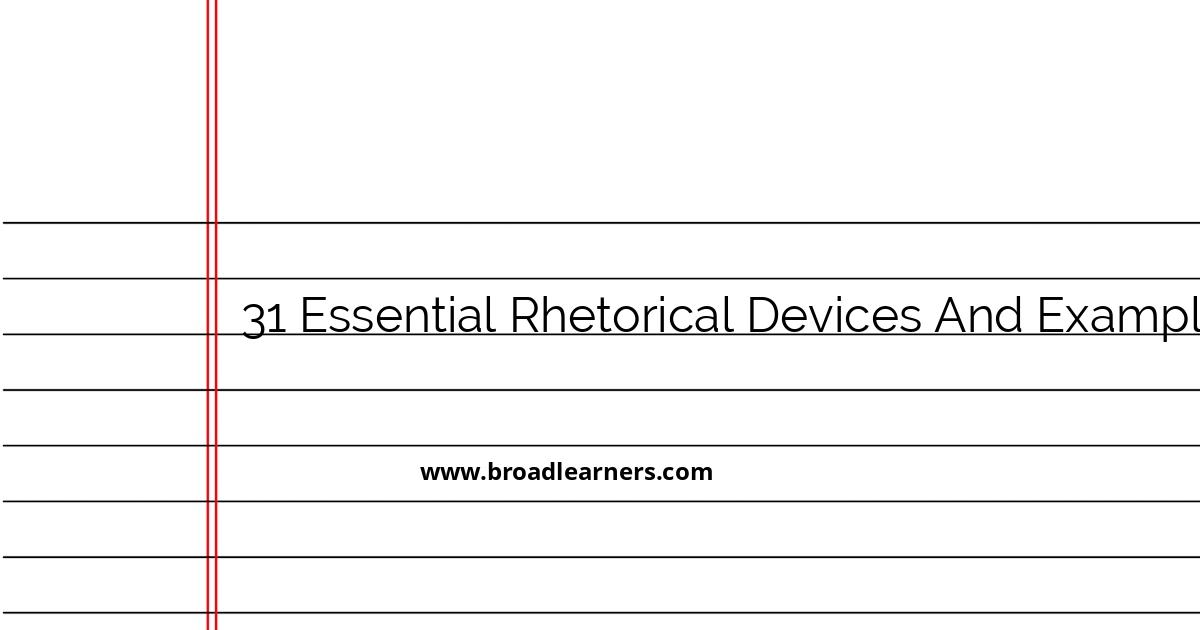Rhetorical devices are techniques or strategies used by writers and speakers to persuade, impact, or evoke an emotional response from their audience. Understanding these devices is crucial for anyone who aims to improve their writing or public speaking skills. Below, we have outlined 31 essential rhetorical devices, along with examples to demonstrate their use:
- 1. Alliteration
- This device involves the repetition of the same letter or sound at the beginning of closely connected words. Example:
- 2. Allusion
- This is an indirect or passing reference to an event, person, place, or artistic work. Example:
- 3. Anaphora
- The repetition of a word or phrase at the beginning of successive clauses. Example:
- 4. Antithesis
- This juxtaposes contrasting ideas in balanced phrases or clauses. Example:
- 5. Apostrophe
- Addressing an absent or imaginary person, or a personified abstraction. Example:
- 6. Assonance
- The repetition of vowel sounds in nearby words. Example:
- 7. Chiasmus
- A rhetorical or literary figure in which words, grammatical constructions, or concepts are repeated in reverse order. Example:
- 8. Euphemism
- A mild or indirect word substituted for one considered to be too harsh or blunt. Example:
- 9. Hyperbole
- Exaggerated statements or claims not meant to be taken literally. Example:
- 10. Irony
- Using language that normally signifies the opposite, typically for humorous or emphatic effect. Example:
- 11. Litotes
- An ironical understatement in which an affirmative is expressed by the negative of its contrary. Example:
- 12. Metaphor
- Describing a subject by asserting that it is, on some point of comparison, the same as another otherwise unrelated object. Example:
- 13. Metonymy
- Replacing the name of a thing with the name of something else with which it is closely associated. Example:
- 14. Onomatopoeia
- A word that phonetically imitates the sound that it describes. Example:
- 15. Oxymoron
- A figure of speech in which apparently contradictory terms appear in conjunction. Example:
- 16. Paradox
- A statement that contradicts itself but might contain a plausible truth. Example:
- 17. Personification
- Attributing human characteristics to something non-human. Example:
- 18. Simile
- Comparing one thing with another thing of a different kind, used to make a description more emphatic or vivid. Example:
- 19. Synecdoche
- A figure of speech in which a part is made to represent the whole or vice versa. Example:
- 20. Understatement
- A technique for developing irony and/or humor where one writes or says less than intended. Example:
- 21. Anadiplosis
- The repetition of the last word of a preceding clause at the beginning of the next one. Example:
- 22. Zeugma
- A Figure of speech in which a word applies to multiple parts of the sentence. Example:
- 23. Anthimeria
- The use of a word in a new grammatical form, most often the usage of a noun as a verb. Example:
- 24. Antanaclasis
- The repetition of a word or phrase whose meaning changes in the second instance. Example:
- 25. Polysyndeton
- The deliberate use of a series of conjunctions. Example:
- 26. Asyndeton
- Omission of conjunctions between coordinate phrases, clauses, or words. Example:
- 27. Climax
- The arrangement of words, phrases, or clauses in an increasing order of importance or power. Example:
- 28. Epistrophe
- The repetition of a word at the end of successive clauses or sentences. Example:
- 29. Erotesis
- A rhetorical question implying strong affirmation or denial. Example:
- 30. Hendiadys
- Expressing a single idea by two nouns instead of a noun and its qualifier. Example:
- 31. Pleonasm
- Use of more words than are necessary to convey meaning, either as a fault of style or for emphasis. Example:
"She sells seashells by the sea-shore."
"This place is like a Garden of Eden."
"Every day, every night, in every way, I am getting better and better."
"It was the best of times, it was the worst of times."
"O death, where is thy sting? O grave, where is thy victory?"
"The early bird catches the worm."
"Never let a Fool Kiss You or a Kiss Fool You."
"He passed away" instead of "he died."
"I'm so hungry I could eat a horse."
"A plumber's house always has leaky pipes."
"Not too bad" instead of "very good."
"Time is a thief."
"The White House issued a statement."
"The bees buzzed in the garden."
"Deafening silence."
"Less is more."
"The wind whispered through the trees."
"As brave as a lion."
"All hands on deck."
"It's just a scratch," when referring to a large dent.
"Fear leads to anger. Anger leads to hate. Hate leads to suffering."
"He stole both her heart and car that fateful night."
"I could use a good sleep."
"If you aren't fired with enthusiasm, you will be fired with enthusiasm."
"We have ships and men and money and stores."
"I came, I saw, I conquered."
"There are three things that will endure: faith, hope, and love. But the greatest of these is love."
"See no evil, hear no evil, speak no evil."
"Isn't it a bit too much to expect?"
"Sound and fury" instead of "furious sound."
"I saw it with my own eyes."
By mastering these rhetorical devices, you can enhance your writing and speaking abilities, making your communication more engaging and persuasive. Each device has its unique way of adding depth to your expressions, contributing significantly to effective rhetoric.

Did I miss anything? Respond below